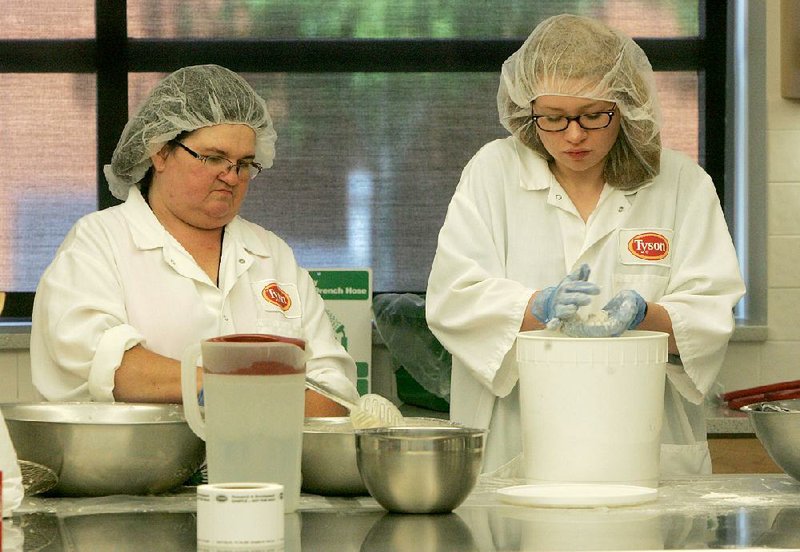SPRINGDALE - Tyson means poultry. Everybody knows that, right?
Increasingly, however, Tyson has evolved into a full-service protein company with beef leading the way, accounting for nearly 40 percent of its revenue, followed by chicken at 35.6 percent and pork at 15.1 percent.
Well down the list, but growing in importance, is the prepared-foods sector at 9.25 percent. That’s where the Tyson Discovery Center - a catchy name for its test kitchens - comes into play. The company calls it an “ industry leading research and development complex designed to enhance Tyson’s ability to collaborate with customers to create new foods and bring them to market quickly” and “a hub of food innovation that uses consumer insight as well as culinary and manufacturing expertise to develop and test new products.”
The 100,000-square-foot facility houses 19 research kitchens and an adjacent U.S. Department of Agriculture inspected pilot production plant, which the company says enables it to take retail and food-service concepts to market quickly.
The company has about 12,000 products, combining retail and food service, chef Tony Lockard said on a recent tour of the complex.
“We’re going to design the product depending on our customer,” he said as he showcased breaded chicken sold at retail stores. “They want it fried up nice and crisp.” A non-fried version is sold to delis.
The company will redesign products, Lockard said, depending on what the customer wants - such as spicy or not. When the company works with Asian restaurant chains, he said, “they take care of the sauce, typically a sweet and sour or a sweet and spicy.”
According to global consumer research firm NPD Group, based in Port Washington, N.Y., the consumption of prepared foods will grow at twice the pace of restaurant visits during the next decade.The company released its forecast this month.
NPD Group said its research indicates that purchases of prepared foods for at home consumption likely will increase by 10 percent during the next decade, compared with an expected 4 percent increase for commercial food service traffic. The company’s research found that adults 35 years and older are more likely than their younger counterparts to buy prepared foods for home consumption.
“Capturing visits from direct competition, like prepared-foods retailers, has been the primary source for a restaurant operator’s growth over the past 10 years, and this will continue to be the case,” Bonnie Riggs, NPD Group restaurant industry analyst, said in the report. “Efforts to pull consumers out of their homes and back into restaurants will require touting the benefits of eating out versus staying at home and cooking, or eating meals offered by home-meal replacement retailers.”
About 180 people work in Tyson’s research and development, including 80 food technologists and 60 doctorate-level staff members trained in meat and poultry science.
“We call them meatheads,” Lockard said. “They are the experts, and they’re really thinking about how do I design this product to everyone’s interests?”
Karen Shank, manager of Tyson’s Nutrition Group Research and Development Discovery Center, said the company has had a process in place for five years to reduce salt in prepared foods. She said the company works directly with retail customers.
“From my perspective as a dietitian, that’s a good thing,” she said.
Shank said she recently visited the U.S. Centers for Disease Control and Prevention to get the latest statistics on how people eat and also looked at advice from the Food and Drug Administration.
“I think it’s safe to say we’re ahead of the curve,” she said, adding, “Food still has to taste good. People won’t eat it if it doesn’t taste good.”
Craig Bacon, senior vice president of research and development at Tyson, said the company hosts focus groups every month “to show them a bunch of new stuff,” in addition to hosting separate focus groups as requested by its customers. And the company, he said, also hosts “sensory panels” of consumers to gauge their likings.
“We’re no fun to go out to eat with,” Bacon said. “We start breaking food apart, and you hear comments like, ‘I wouldn’t do it that way.’”
Tyson also draws on the expertise of Kerry Group PLC, a global company with roots in a dairy cooperative in Ireland that has grown into a world leader in food ingredients and flavors.
Kerry chefs are embedded in Tyson’s research and development, he said.
At the BMO Capital Markets 2013 Farm to Market Conference in May, Donnie Smith, Tyson’s president and chief executive, told investors that developing new food products is an important part of the company’s growth strategy and that the company has an aggressive product launch plan for the year.
“We must continue to provide product innovation to drive traffic and sales for our customers,” he said. “When they see weak consumer demand, operators are more interested than ever in our new product ideas and businessbuilding opportunities.”
Business, Pages 68 on 07/28/2013
